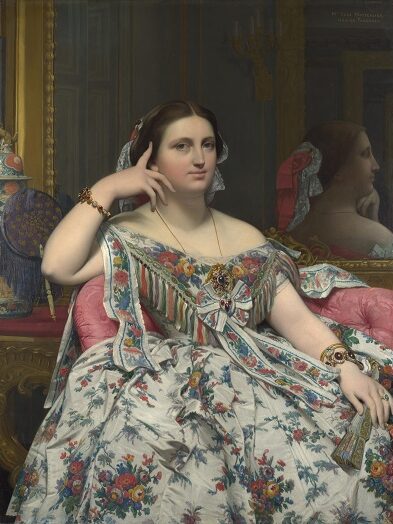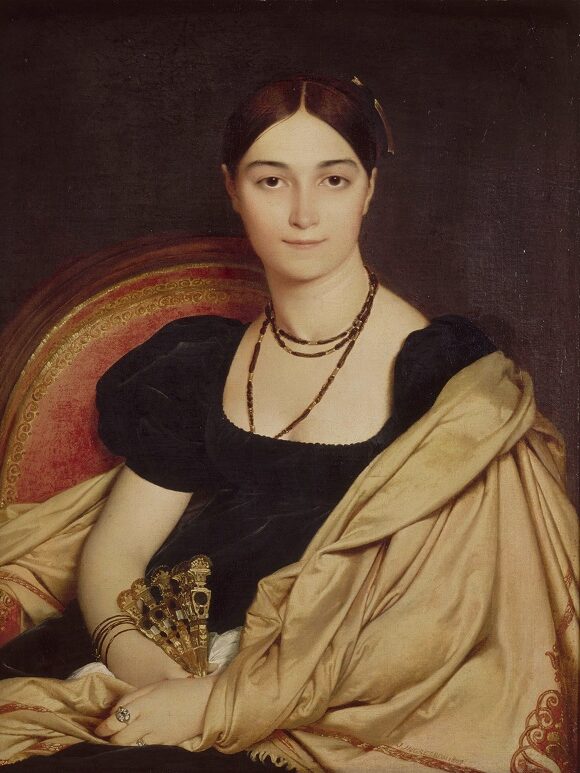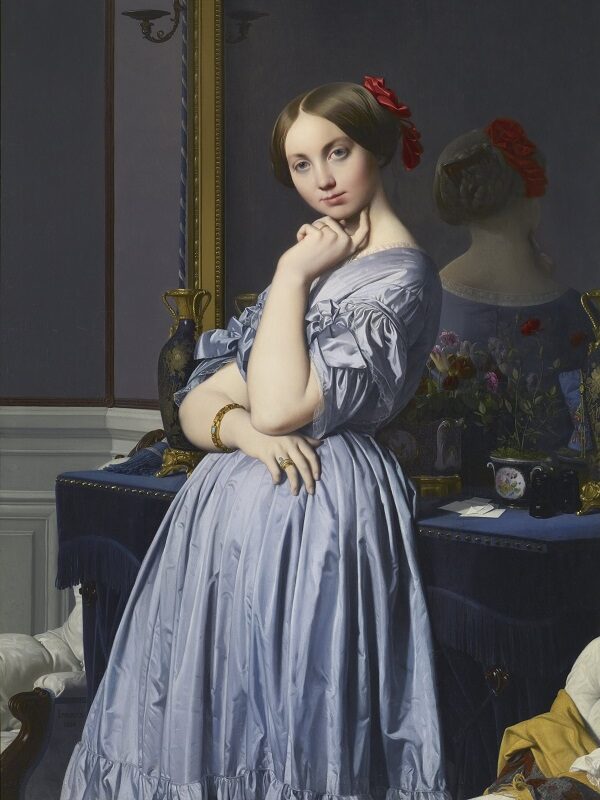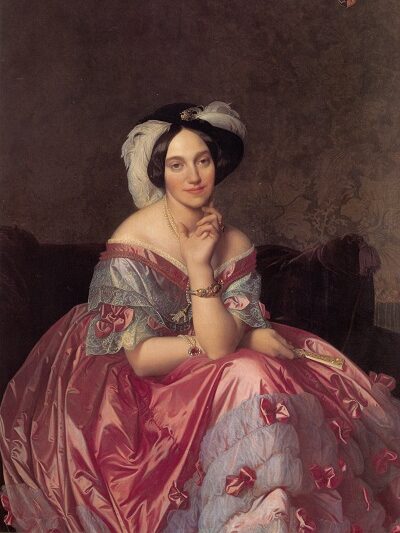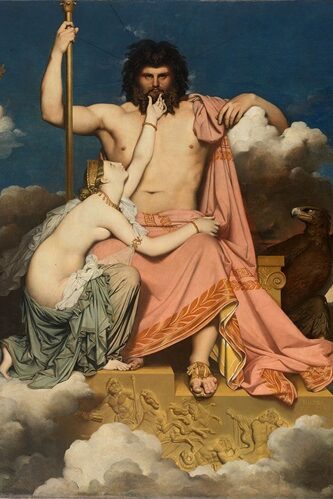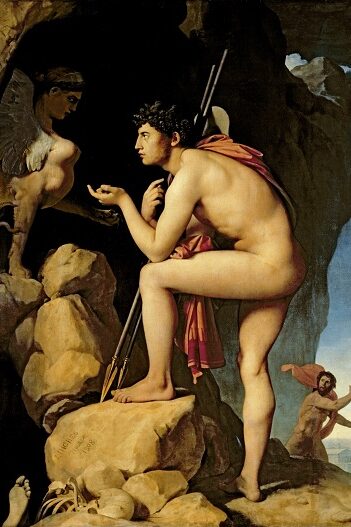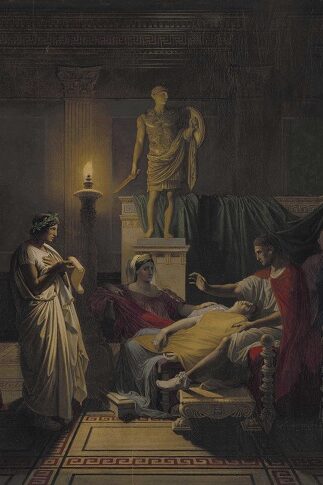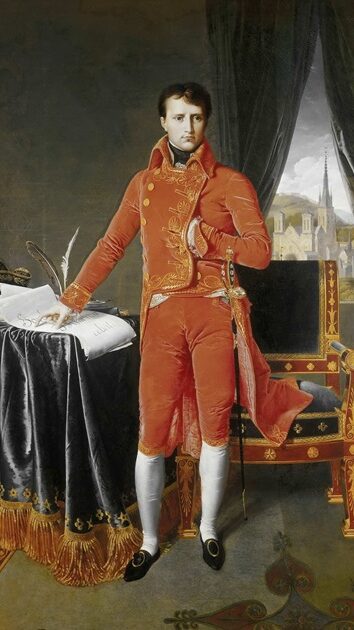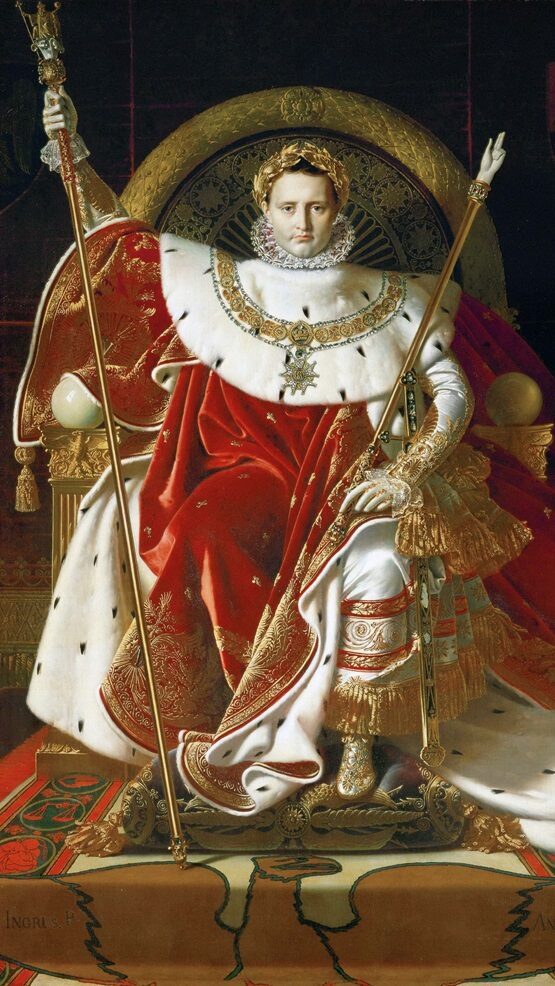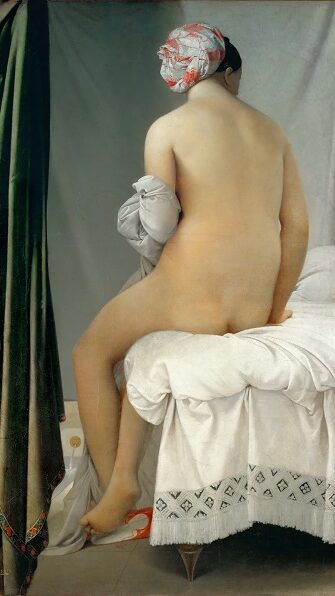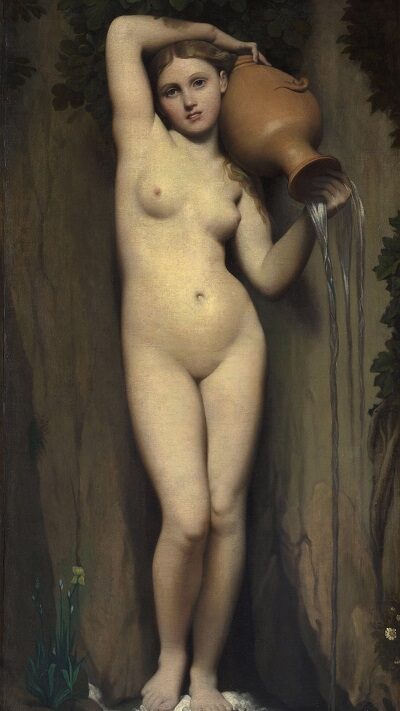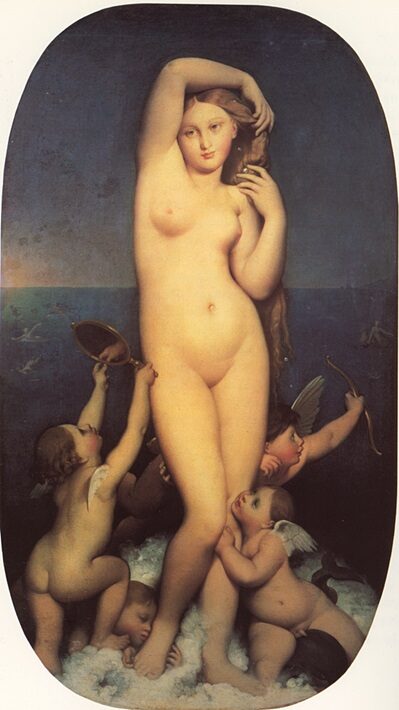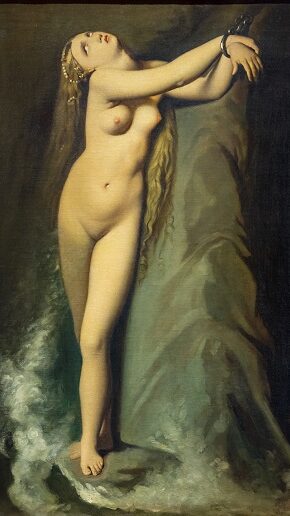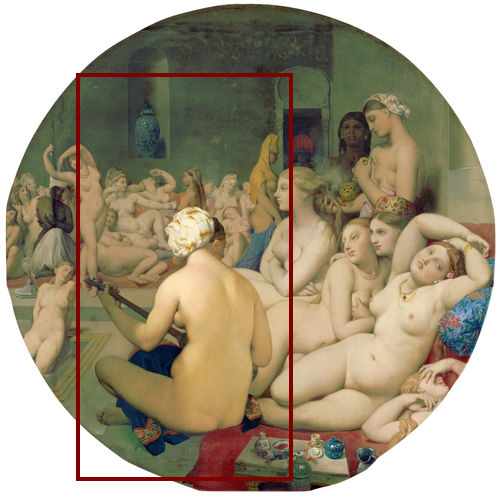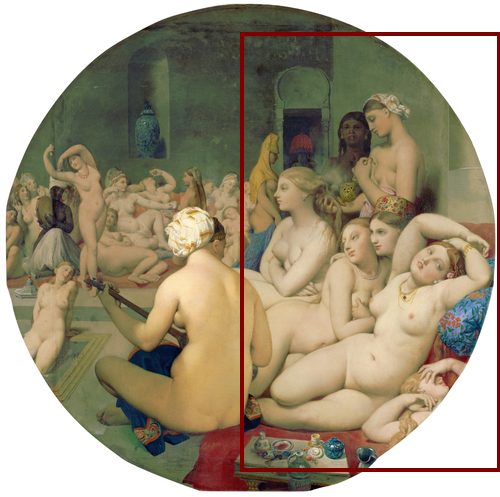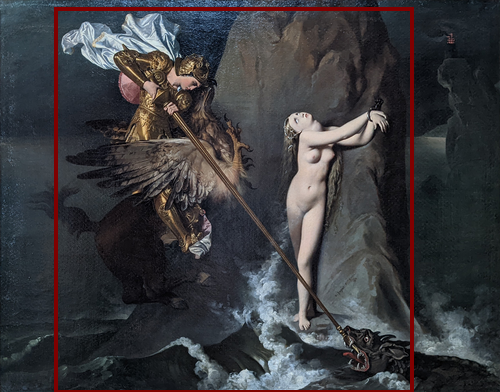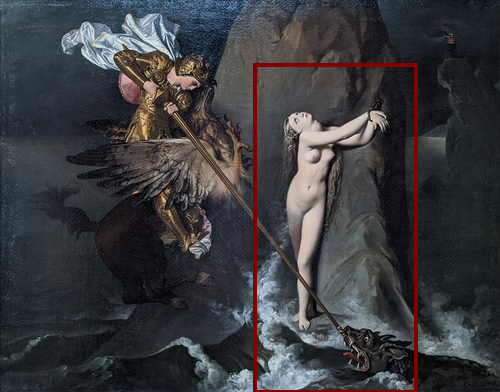Paintings of Ingres (1780-1867) the great French artist. He was considered one of the great painters of the Neoclassical style. Awesome history paintings, nudes and portraits.
All images in this post can be expanded and scroll viewed. You can watch details difficult to see with normal viewing. To experience this, just click. The images will expand and scroll view automatically. Futher, in the scroll views, click control tabs on the upper left corner to fast scroll (skip button), expand, minimize, shift right or left, pause or scroll up or down.
The Portraits of Ingres
Dominique Ingres is considered a great portait painter. In fact some consider this to be his greatest legacy. In particular he excelled in painting women and there was a list of women waiting to pose for him. He spent many hours, days, years painting and engraved their essence into his paintings.
Numbered from left to right
- Madame Moitessier (1856) : This took Ingres 12 years to complete. It shows the beautiful Marie-Clotilde-Inès Moitessier, wife of a wealthy merchant, sitting in an armchair, surrounded by the luxury of her grand salon. A captivating likeness balancing her imperious pose with a reflection in the mirror behind her. A masterpiece. However 19th century critics have pointed out that her hand in the mirror cannot possibly be a true reflection. Also “anatomically incorrect, arms too long; hands with no bones” said the critics. Yet a hundred years later Picasso was fascinated by the deviations from formal, academic precision and created a painting incorperating some of the characteristics of Ingres’ work.
- Portrait de Madame Duvaucey (1807) : The atmostphere is faintly erotic. She stares at you suggestively with a slight smile. She is clothed lavishly with expensive looking fan, rings and necklace. The woman is Antonia Duvauçey of Nittis, mistress of Charles-Jean-Marie Alquier who was ambassador to the pope in his role as the Bishop of Rome. As was his wont Ingres deviates from the norm. The woman’s arms are out of proportion, her left being longer than her right. The neck is too thin. But the total result appeals. This was widely praised at the 1833 Salon for Ingres’ skill with line; the distinct curves placed against a background.
- Portrait of Comtesse d’Haussonville (1845) : The subject Louise Princess de Brogli was 27 at the time of the portrait. She was a highly educated young woman of the times and later became an essayist and biographer. She came from a French aristocratic family. Her father was statesman and diplomat Victor de Broglie, 3rd Duke de Broglie, her mother was Baroness Staël von Holstein. The portrait captures the modesty, worldliness, elegance and intellectualty of Louise well. It was exhibited in Paris in 1846, then again and again in 1855, 1867, 1874, and 1910.
- Portrait of the Baronness James de Rothschild (1848) : The portrait is said to be one of Ingres’ best. It has been described as “perhaps the most sumptuous yet approachable image of mid-nineteenth-century opulence.” The subject is Betty de Rothschild, one of the wealthiest women in Europe at that time. Her beauty and elegance was widely known. The challenge was to harmonise her material wealth with the dignity, grace and beauty of the subject. Betty de Rothschild is in expensive clothing and has costly ornaments but casually crosses her legs and leans foward, creating an impression which is both aproachable and elegant.
The Classical Paintings OF Ingres
Numbered from left to right
- Jupiter & Thetis (1811) : Created by young Ingres when he was only 31. Yet all of Ingres’ characteristics are already there. Adherence to the traditions of classical and Neoclassical art, attention to line and dismissal of anatomical accuracy. The scene is from Homer’s Iliad. The two poeple depicted are Thetis, mother of Achilles and the Greek god Jupiter. Thetis is imploring Jupiter to save her son who is fated to die in the Trojan war. The contrast between the all powerful god and the curvaceous Thetis is striking. Force versus langour and gentleness. Man against woman.
- Oedipus and the Sphinx (1808) : This shows Ingres working in pure classical or Neoclassical style. The scene is from Greek mythology and the Sphinx is asking a riddle. “What goes on four legs in the morning, two legs in the afternoon, and three legs in the evening?” If the answer is wrong she kills and devours the answerer. Oedipus gives the correct answer “”Man—who crawls on all fours as a baby, walks on two feet as an adult, and uses a walking stick in old age”. As a result the Sphinx kills herself and Oedipus travels to Thebes and becomes it’s king.
- Virgil Reading from the Aeneid (1864) : The Aeneid is a poem telling the legend of Aeneas, a Trojan who fled the fall of Troy, travelled to Italy and founded Roman. Roman poet Virgil created it between 29 and 19 BC. It glorified traditional Roman virtues and legitimised the Roman dynasty as descendants of the founders. This painting depicts the moment Roman poet Virgil while reciting his work to the Roman Emperor Augustus, wife Livia and sister Octavia, mentions Octavia’s late son, Marcellus causing Octavia to faint with grief. Ingres revisited this scene from the past in over 100 drawings and watercolours and paintings.
- Raphael and the Fornarina (1814) : At the end of the 18th century, paintings glorifying the lives of famous artists became popular. This is one such painting. It shows the famous Renaissance painter, Raphael, sitting in his studio with his mistress, La Fornarina on his knee. Raphael is embracing her, but at the same time he is looking at a portrait. This symbolizes Raphael’s dilemma, he loves her but he also loves his work.
Historic Paintings OF Ingres
Numbered from left to right.
- Joan of Arc at the Coronation of Charles VII (1854) : Joan of Arc is France’s national heroine. All French children learn about her at school. The story is : France was fighting the Hundred years’ war against England and loosing, Joan was a peasant girl of 17 but she heard a voice from heaven telling her to lead the French army. She led the French army to a great victory at Orléans in 1429. The scene above shows Joan at the coronation of Charles VII of France in Reims Cathedral. To her right are the monk Jean Paquerel, and a servant. The servant is Ingres himself.
- Bonaparte, First Consul (1803/1804) : On 1 August 1803 Napoleon Bonaparte stopped in the newly annexed city of Liège for two days. To show his satisfaction, Bonaparte offered the city a portrait of him done by Ingres who was 23 at the time. Bonaparte was at the hight of his power and became Emperor soon after. The painting itself shows Bonaparte in a civilian pose, hand in his jacket. He is not resting his hand on his sword in martial pose. In the background is St. Lambert’s Cathedral which was not complete at that time but being restored to demonstrate to the city the benefits of being part of France. This is a political statement portraiying Bonaparte as reconstructor not conquerer.
- Napoleon on his Imperial throne (1806) : Today it is one of the most famous paintings of Emperor Napoleon. However this painting was not well received by the public at first, probably due to it’s archaic quality. lack of harmonious colouring and overall chilliness. Ingres was one of several to get commissions to portray Napoleon at his coronation at Notre Dame de Paris in December 1804. The aim of the coronation was the legitimizsation the Napoleon dynasty. This can be seen in the the scepter of Charlemagne he holds in his right hand, the scepter of justice in his left, the golden laurel wreath on his head similar to that of Julius Caesar and the purple velvet cloak he wore. Purple being the color of the Roman emperor. All this was flawlessly painted with thorough attention to detail by Ingres.
- Portrait of the King Charles X of France in coronation robes (1829) : This shows King Charles X of France, the last Bourbon monarch of France. His reign (1824-1830) was full of instability and social unrest. He abdicated in 1830. In this painting he is wears the anointment robe, a symbol of his divine right to rule. His regal bearing and piercing gaze convey dignity. Ingres brings the man to life with his precise brushstrokes and meticulous attention to detail.
The Nudes
Numbered from lft to right
- La Grande baigneuse (1808) : One of Ingres’ celebrated works. It depicts a nude woman showing her her back to the viewer. She is in a private moment sensual yet chaste. Viewers will find joy in the subtle gradation of tone in her smooth skin. In a break from tradition, she is not based on any figure in mythology or history. This is a celebration of feminine beauty in a general sense, not a celebration of a specific woman or goddess. Ingres painted multiple nudes in his carreer but this is regarded as his first serious treatment. The nudes culminated in The Turkish bath (1863) where the nude in the center has similar overtones as the nude in this painting.
- The Spring (1820-1856) : “Spring” in this context symbolizes “purity” or ” the source of life” or “the origin of art/inspiration”. In the painting a beautiful young woman holds a pitcher above her shoulder and water runs from it. She is the spring or source. She is innocent and pure, the origin. The smooth skin of the woman is a tribute to Ingres’ skill in rendering the human form. The painting was completed when Ingres was 76, famous and president of the prestigeous École des Beaux-Arts.
- Vénus anadyomène (1808-1848) : The title means “Venus, Rising from the Sea”. The idea for this is said to have originated 2nd – 3rd century AD. There is mention by a Greek rhetorician called Athenaeus that the inspiration came from courtesan Phryne swiming nude in the sea at the time of the Greek festivals. Multiple images of Venus nude in the sea exist from the time of the Romans to the High Middle Ages. It took Ingres from 1808 to 1848, about 40 years to complete his version of Venus.
- Study for Roger delivering Angélique (1819) (CC BY-SA 4.0 DEED) : The inspiration for this painting is the story of Roger, a knight riding on a hippogriff (a legendary half horse and half eagle horse) who sees a beautiful woman, Angelica chained to a rock. She has been captured and offered as a sacrifice to a sea monster. Roger kills the monster and rescues her. The story is a 16th-century poem called Orlando Furioso by Ariosto.
Partial Views
Click the images. Portions of the images enclosed in the red rectangle will expand and automatically scroll view enabling you to see the details.
The Turkish bath (1862) : This is said to be the masterpiece of Ingres’ later years, when he was 82-83. In the painting, dozens of nude women languish on sofas. The atmosphere is Oriental, voluptuous, sensual, erotic. Looking closely one sees similarities to Ingres’ past nudes. The woman with the mandolin presenting her back is similar to “La Grande baigneuse (1808)” and similarities to “La Grande odalisque (1814)” can be seen. It is a testmony to Ingres’ interest in the female body. The painting was so erotic it was not shown to the public until 1905, after Ingres’ death. Then it was praised by many, including Picasso and Matisse the greats of modern painting.
Roger freeing Angélique (1819) : Many studies for the individuals and composition exist. “Study for Roger delivering Angélique (1819)” which is shown above is one of them. Ingres received a commission for the composite painting in 1817 and finished t in 1819. It was exhibited at the Paris Salon of 1819 together with his Grande Odalisque,
About Jean Auguste Dominique Ingres (1780–1867)
Ingres was born in a modest familly in Montauban, France, His father was Jean-Marie-Joseph Ingres and his mother was Anne Moulet. He was the first of 7. His father did pretty much everything, painter of miniatures, sculptor, stonemason, amateur musician and instructed him in drawing and music. He attended the local school but it was shut down because of the French Revolution in 1791 when he was 11.
After this, Ingres was taken to Toulouse and studied in various disciplines, such as sculpture, architecture, painting and music and won prizes. He decided to become a history painter which was considered the highest level of painting at that time. He would paint the greats in religion, history and mythology and glorify them for future generations. He would not just make portraits or illustration like his father.
He must have been very talented. In 1789 he went to Paris and studied under Jacques-Louis David who was the leading painter in Europe at that time. In David’s studio he tended to work alone, was very studious, modeled with correctness and fine attention to contour.
In 1799 he was admitted to the École des Beaux-Arts. In 1801 he took Prix de Rome the top prize of the Academy. In 1802 he debuted in the Salon with Portrait of a Woman. This was the beginning of his celebrated portraits which were extremely exact, particularly in the details of their clothing. He also studied Italian Renaissance paintings,which Napoleon had brought back from his campaign in Italy and assimilated their styles into his own portraits. In 1803/1804 he got a commission to portray Napoleon (Bonaparte, First Consul. He was one of only five to receive it.
In 1806 he went to Rome to study. This was his reward for the Prix de Rome he got in 1801. Some of the paintings he completed or begun In Rome were Portrait de Madame Duvaucey (1807), La Grande baigneuse (1808), Oedipus and the Sphinx (1808). He wanted to do history painting but at that time a lot of the paintings he created were portraits.
The paintings of Ingres up to the early 1800s were not well received. They were critisised for being anatomically incorrect, arms too long, fingers with no bones, flat, airless quality etc.. “Gothic” for example was the word used to describe Napoleon on his Imperial throne (1806). This trend changed only after the Salon of 1824 when The Vow of Louis XIII brought Ingres some success.
In the early 1800s Ingres had some serious issues with his critics in France. Because of them he refused to return to Paris and this had lead the break up of his engagement to Julie Forestier, his then fiance. His prospects were uncertain but in 1813 he married Madeleine Chapelle, recommended to him by friends in Rome. The marriage was a happy one.
He received some commissions but in 1815 Napoleon’s dynasty fell and Ingres found himself in Rome without patronage. Hard times had come.
Ingres had to augment his income by drawing portraits of wealthy tourists passing through Rome. He created hundreds and today they are some of his most liked works.
In the Salon of 1824 The Vow of Louis XIII finally brought Ingres success. most critics praised it. In 1825 Ingres was awarded the Cross of the Légion d’honneur, and in June 1825 he was elected member of Académie des Beaux-Arts.
However in 1834 another hiatus. That year he presented his The Martyrdom of Saint Symphorian but people attacked it. Ingres regarding it as the culmination all of his work and skill had worked on it for ten years. He was hurt. He declared that he would never participate in the Salon again and returned to Rome where he became the Director of the Academy of France.
Ingres spent 6 years (1834–1841) in Rome. He re-organized the Academy and trained the students. The Academy had a branch for music. Some of the musical artists he came to know were Franz Liszt, Fanny Mendelssohn, composer Charles Gounod and violinist Niccolò Paganin. His anger at the Paris establishment did not lessen but he did send some of his works to patrons in Paris. In 1840 he was offered a commission for a portrait of the Duke d’Orléans, the heir to the throne and another to create murals for the Château de Dampierre. He returned In April 1841.
Ingres spent his last decades (1841-1867) in Paris. He became a professor at the Ecole des Beaux-Arts. He completed his Venus Anadyomene (1808-1848). In 1849 his wife died and he resigned as professor at the École des Beaux-Arts. But in 1852 when he was 71 he remarried. Ingres was reborn. In 1854 he completed a history painting, Joan of Arc at the Coronation of Charles VII and in 1856 The Source. In 1862 he was awarded the title of Senator, and made a member of the Imperial Council on Public Instruction. The famous materpiece The Turkish Bath was completed in 1862. However it is known that he still continued work on it in 1863 . He died in 1867 at the age of 86.
Notes
The comments above reflect only the thoughts the administrator had while viewing the images. They might or might not be comments by the subjects or the photographers etc.. Please excuse any inaccuracies. You are welcome to leave comments in the comment space. Otherwise send messages to “kohi@scroll.kohibiz.com”.
The images are from Wikimedia Commons. All are believed to be in the public domain unless otherwise noted. If there are any problems please leave a message. Images will be taken down if necessary. Many thanks to Wikimedia Commons and the artists and photographers for making these superb images available. Some images have been cropped from the original using the Vertical Scroller application program. This is to ensure the best viewing experience.
